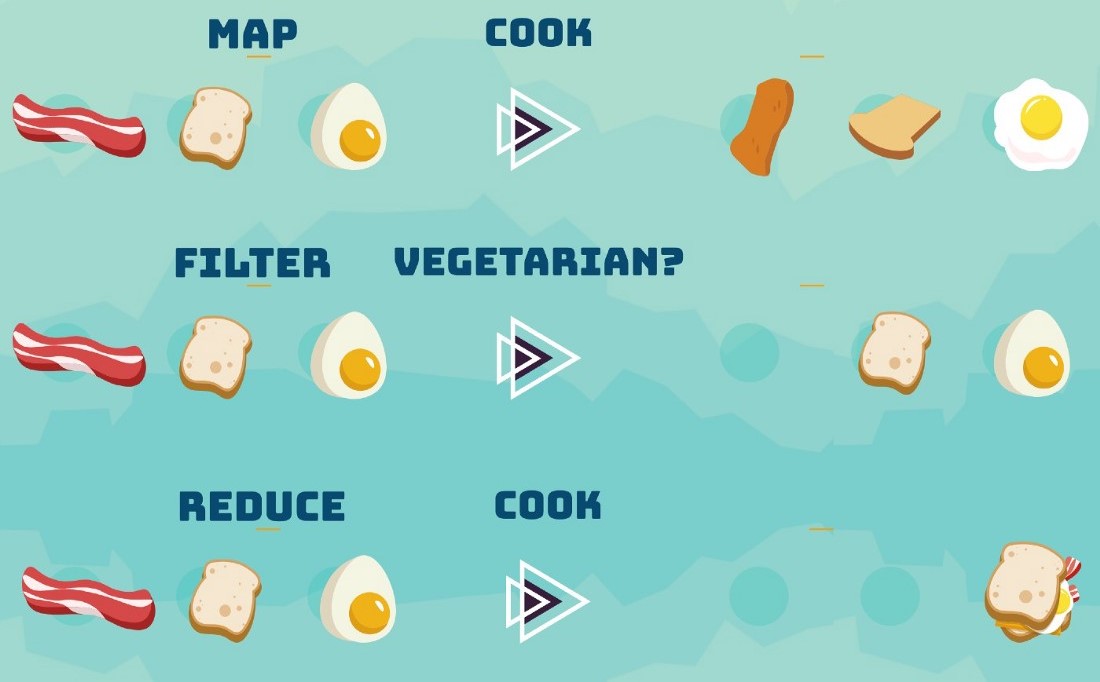Learning Python with Advent of Code Walkthroughs
Dazbo's Advent of Code solutions, written in Python
The Python Journey - Map, Filter, and Reduce

Useful Links
map
The map() function applies a function against every member in a sequence. The function takes two arguments:
- The function we need to apply to each member of the iterable, without the parentheses.
- The iterable itself.
Example: Converting from Str to Int
Here we apply the int() function to each member of a list. The original list contains str values.
def print_seq(seq):
for item in seq:
print(f"{item}, type: {type(item)}")
sequence = ['1', '2', '3', '4', '5'] # list of str values
print("Items in sequence...")
print_seq(sequence)
new_seq = map(int, sequence) # convert each str to an int
print("Items in new_seq...")
print_seq(new_seq)
Output:
Items in sequence...
1, type: <class 'str'>
2, type: <class 'str'>
3, type: <class 'str'>
4, type: <class 'str'>
5, type: <class 'str'>
Items in new_seq...
1, type: <class 'int'>
2, type: <class 'int'>
3, type: <class 'int'>
4, type: <class 'int'>
5, type: <class 'int'>
Example: Getting Word Lengths
Here we split a phrase into its constituent words. Then we apply the len() function to each word, to determine the length of each word.
PHRASE = "The quick brown fox jumped over the lazy dog"
words = PHRASE.split()
word_lengths = map(len, words)
for word, word_len in zip(words, word_lengths):
print(f"Word: {word}, length: {word_len}")
Output:
Word: The, length: 3
Word: quick, length: 5
Word: brown, length: 5
Word: fox, length: 3
Word: jumped, length: 6
Word: over, length: 4
Word: the, length: 3
Word: lazy, length: 4
Word: dog, length: 3
filter
The filter() function applies a function to each member of an iterable. The function it applies must always return a boolean. If the function returns True, then this member of the iterable is included in the iterable returned by the filter() function itself. If the function returns False, then this member is not included.
TL;DR: We can use filter to apply filtering criteria to a collection, and only return those items that meet the criteria.
As with map(), the filter() function takes two parameters:
- The function that is used to filter our collection, without the parentheses. It must return a boolean.
- The iterable itself.
Example: Filtering Based on Word Length
If we continue our example from above, we could write a filter to only return words that have 5 characters or more:
long_words = list(filter(lambda x: len(x) >= 5, words))
print(long_words)
Output:
['quick', 'brown', 'jumped']
Note that we’ve used a lambda function as the first parameter to filter().
reduce
The reduce() function applies a function successively to each element in an iterable. It starts by applying the function to elements 1 and 2, resulting in a so-called aggregator value. It then applies the function to the aggregator value and element 3, resulting in a new aggregator value. Then it applies the function to the new aggregator value and element 4, and so on.
Ultimately, the reduce() function reduces the iterable down to one final value.
The reduce() function is often called fold in other languages.
As with the map() and filter() functions, reduce() takes two parameters:
- The function that is applied sequentially, without the parentheses. This function must itself accept two parameters.
- The iterable itself.
Example: Using Reduce() to Implement a Factorial Function
from functools import reduce
def mul(a, b):
prod = a * b
print(f"{a} * {b} = {prod}") # so we can see the interim values
return prod
fac = reduce(mul, range(1, 11))
print(f"Result = {fac}")
Output:
1 * 2 = 2
2 * 3 = 6
6 * 4 = 24
24 * 5 = 120
120 * 6 = 720
720 * 7 = 5040
5040 * 8 = 40320
40320 * 9 = 362880
362880 * 10 = 3628800
Result = 3628800
Note that to use reduce(), it has to be imported from functools.